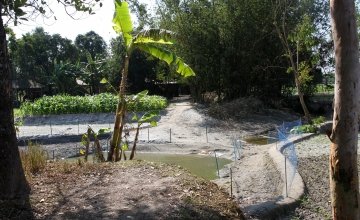
Read our 2023 annual report

Knowledge Hub
Understanding Natural Capital and Flood Resilience in Bangladesh
This report shares the findings from the Natural Capital assessment work carried out to date by Concern as part of its contribution to the Zurich Flood Resilience Alliance programming in Bangladesh to apply the Flood Resilience Measurement for Communities (FRMC) Framework to support community-based pre-event flood resilience.

The natural capital assessments were carried out with the support of Esolve International in the 22 communities in which Concern is implementing the programme in Bangladesh. Concern is implementing this flood resilience programme with a local partner ASOD (Assistance for Social Organization and Development) in Lalmonirhat and Gaibandha districts.
Key Findings
- Relevance of the flooding environment to the community's experience of flooding. Land elevation is significant in relation to the experience of severe flooding, while interactions between land use, land elevation, natural capital and flooding intensity is important to understand. The assessment of natural capital suggested that communities do not associate natural capital to a role in flood management, but experience natural capital in relation only to productive livelihoods.
- Upstream and downstream interactions can affect flood control options. The natural capital work did not present solutions, but indicated that approaches to modify flooding in one location could have significant unexpected consequences for downstream locations.
- Business as Usual is not working. The continued use of natural capital for the use of productive livelihoods is no longer a viable solution, while land gearded to cultivation and livestock introduces its own challenges in relation to flood control management. While conventional approaches to water flow management such as dredging, embankments and revetments, are too expensive for the communities assessed there is a need for a more balanced and nuanced approach looking at the relative values of green, blue and grey infrastructure to assist in community based pre-event flood resilience.
- Building innovative solutions is important. The FRMC is leading to new solutions to address the problems in flooding, such as Natural Capital Community Clusters and new insights into land use management practices such as seasonal planting in dry riverbeds (Nala).
- Need for a coherent natural capital strategy. The FRMC asks the question whether natural capital solutions are appropriate and are of the right combination of green, blue and grey to address flooding risk. This assessment should be based on a clear natural capital management strategy.
The report illustrates that natural capital does not currently have a central focus in flood risk management in Bangladesh, at least in the programme areas of intervention, and that from a policy and community perspective there is a limited understanding of the role of natural capital to enable communities to better cope with flooding.
Learning brief
Concern gathered information through interviews with key implementing programme staff (including partners) and documents produced as outputs of the process in order to pull out the key learning. This resulted in the below brief which contains the learnings of the programme team throughout the journey from preparation of the FRMC to developing community resilience action plans.

Key Learning
- Engaging communities in the process from the beginning was vitally important to the success of the programme. This included a particular focus on women and other marginalised groups in the communities such as youth, people with disabilities and the elderly. The Community Action Plans included the needs of women and those of other marginalised groups that were identified by each community.
- The Community Resilience Vision Statements are a unique innovation that helped engage new communities with a complex process. The Resilience Statements provided a platform on which to communicate quite a complex grading assessment of resilience in a way that the community can relate to. This improved acceptance and maintained ownership of the process at the community level.
- It was important to include women in all aspects of the programme, to build their capacity and confidence, but also to allow the men to get used to having women involved. This was important for the long-term sustainability of the programme to ensure that women continue to participate in decision-making in their communities after the programme has finished.
- The technicality of language and the FRMC tool itself required all Concern and partner staff to be adequately trained and prepared to facilitate the roll out of the FRMC in communities. It was necessary to invest sufficient time and resources into staff to ensure they were fully prepared to assist community members.
- Both community and programme planning is important. Because the programme plan was developed based on the Community Action Plans, time for this needed to be built into the implementation plan. This is a departure from typical development programmes where monitoring and evaluation (M&E) elements such as M&E Plan and Programme Logframe are developed at the outset in advance of programme activities commencing.
The full learning report can be accessed at the link below:
Download the learning brief
Members of the Zurich Flood Resilience Alliance are funded by the Z Zurich Foundation, with the exception of Zurich Insurance Group. However, the views expressed in this publication do not necessarily reflect the official position of either the Foundation or the company.




